Exploring Phosphorus Fraction Dynamics in Loess Soils: Impact of Long-Term Nitrogen and Phosphorus Fertilization on Cropland and Fallow Land
Abstract
1. Introduction
2. Materials and Methods
2.1. Site Description
2.2. Experimental Design
2.3. Sample Collection and Analysis
2.3.1. Plant and Soil Sampling and Basic Analysis
2.3.2. Soil P Fractions Analysis
2.4. Data Analysis
3. Results
3.1. Crop Yields and Soil Properties
3.2. Soil Total P, Pi, Po, and Pr Fractions
3.3. Organic P (Po) Fractions
3.4. Inorganic P (Pi) Fractions and Olsen P
3.5. Relationships among P Fractions and Soil Properties
4. Discussion
4.1. Soil P Fractions in N and P Fertilized Croplands and Fallow Lands
4.2. Effect of Soil Properties on P Fractions and Crop Yield
5. Conclusions
Author Contributions
Funding
Informed Consent Statement
Data Availability Statement
Acknowledgments
Conflicts of Interest
References
- Zhu, X.; Zhao, X.; Lin, Q.; Alamus; Wang, H.; Liu, H.; Wei, W.; Sun, X.; Li, Y.; Li, G. Distribution Characteristics of Soil Organic Phosphorus Fractions in the Inner Mongolia Steppe. J. Soil Sci. Plant Nutr. 2020, 20, 2394–2405. [Google Scholar] [CrossRef]
- Zhang, G.S.; Xue, J.X.; Ni, Z.W.; Li, J.C. Phosphorus Accumulation and Sorption Characteristics of P-Enriched Soils in the Dian Lake Basin, Southwestern China. J. Soils Sediments 2018, 18, 887–896. [Google Scholar] [CrossRef]
- Zhang, T.Q.; Zheng, Z.M.; Drury, C.F.; Hu, Q.C.; Tan, C.S. Legacy Phosphorus after 45 Years with Consistent Cropping Systems and Fertilization Compared to Native Soils. Front. Earth Sci. 2020, 8, 183. [Google Scholar] [CrossRef]
- Hui, X.; Luo, L.; Wang, S.; Cao, H.; Huang, M.; Shi, M.; Malhi, S.S.; Wang, Z. Critical Concentration of Available Soil Phosphorus for Grain Yield and Zinc Nutrition of Winter Wheat in a Zinc-Deficient Calcareous Soil. Plant Soil 2019, 444, 315–330. [Google Scholar] [CrossRef]
- Raza, S.; Chen, Z.; Ahmed, M.; Afzal, M.R.; Aziz, T.; Zhou, J. Dicyandiamide Application Improved Nitrogen Use Efficiency and Decreased Nitrogen Losses in Wheat-Maize Crop Rotation in Loess Plateau. Arch. Agron. Soil Sci. 2019, 65, 450–464. [Google Scholar] [CrossRef]
- Elrys, A.S.; Desoky, E.S.M.; Ali, A.; Zhang, J.B.; Cai, Z.C.; Cheng, Y. Sub-Saharan Africa’s Food Nitrogen and Phosphorus Footprints: A Scenario Analysis for 2050. Sci. Total Environ. 2021, 752, 141964. [Google Scholar] [CrossRef] [PubMed]
- Wan, W.; Li, X.; Han, S.; Wang, L.; Luo, X.; Chen, W.; Huang, Q. Soil Aggregate Fractionation and Phosphorus Fraction Driven by Long-Term Fertilization Regimes Affect the Abundance and Composition of P-Cycling-Related Bacteria. Soil Tillage Res. 2020, 196, 104475. [Google Scholar] [CrossRef]
- Su, Y.; Ma, X.; Le, J.; Li, K.; Han, W.; Liu, X. Decoupling of Nitrogen and Phosphorus in Dominant Grass Species in Response to Long-Term Nitrogen Addition in an Alpine Grassland in Central Asia. Plant Ecol. 2021, 222, 261–274. [Google Scholar] [CrossRef]
- Verma, S.L. Effect of Compost on Soil Phosphorous Availability. Ph.D. Thesis, University of Adelaide, Adelaide, SA, Australia, 2013; pp. 1–142. [Google Scholar]
- Nannipieri, P.; Giagnoni, L.; Landi, L.; Renella, G. Role of Phosphatase Enzymes in Soil. In Phosphorus in Action: Biological Processes in Soil Phosphorus Cycling; Springer: Berlin/Heidelberg, Germany, 2011; pp. 215–243. [Google Scholar]
- Zhong, H.; Kim, Y.N.; Smith, C.; Robinson, B.; Dickinson, N. Seabird Guano and Phosphorus Fractionation in a Rhizosphere with Earthworms. Appl. Soil Ecol. 2017, 120, 197–205. [Google Scholar] [CrossRef]
- Mayakaduwage, S.; Alamgir, M.; Mosley, L.; Marschner, P. Phosphorus Pools in Sulfuric Acid Sulfate Soils: Influence of Water Content, PH Increase and P Addition. J. Soils Sediments 2020, 20, 1446–1453. [Google Scholar] [CrossRef]
- Vitousek, P.M.; Porder, S.; Houlton, B.Z.; Chadwick, O.A. Terrestrial Phosphorus Limitation: Mechanisms, Implications, and Nitrogen-Phosphorus Interactions. Ecol. Appl. 2010, 20, 5–15. [Google Scholar] [CrossRef] [PubMed]
- Liao, D.; Zhang, C.; Li, H.; Lambers, H.; Zhang, F. Changes in Soil Phosphorus Fractions Following Sole Cropped and Intercropped Maize and Faba Bean Grown on Calcareous Soil. Plant Soil 2020, 448, 587–601. [Google Scholar] [CrossRef]
- Gou, X.; Cai, Y.; Wang, C.; Li, B.; Zhang, R.; Zhang, Y.; Tang, X.; Chen, Q.; Shen, J.; Deng, J.; et al. Effects of Different Long-Term Cropping Systems on PhoD-Harboring Bacterial Community in Red Soils. J. Soils Sediments 2021, 21, 376–387. [Google Scholar] [CrossRef]
- Li, H.; Jiang, D.; Wollenweber, B.; Dai, T.; Cao, W. Effects of Shading on Morphology, Physiology and Grain Yield of Winter Wheat. Eur. J. Agron. 2010, 33, 267–275. [Google Scholar] [CrossRef]
- Wei, K.; Bao, H.; Huang, S.; Chen, L. Effects of Long-Term Fertilization on Available P, P Composition and Phosphatase Activities in Soil from the Huang-Huai-Hai Plain of China. Agric. Ecosyst. Environ. 2017, 237, 134–142. [Google Scholar] [CrossRef]
- Chen, H. Phosphatase Activity and P Fractions in Soils of an 18-Year-Old Chinese Fir (Cunninghamia lanceolata) Plantation. For. Ecol. Manag. 2003, 178, 301–310. [Google Scholar] [CrossRef]
- Lehmann, J.; Lan, Z.; Hyland, C.; Sato, S.; Solomon, D.; Ketterings, Q.M. Long-Term Dynamics of Phosphorus Forms and Retention in Manure-Amended Soils. Environ. Sci. Technol. 2005, 39, 6672–6680. [Google Scholar] [CrossRef]
- Maharjan, M.; Maranguit, D.; Kuzyakov, Y. Phosphorus Fractions in Subtropical Soils Depending on Land Use. Eur. J. Soil Biol. 2018, 87, 17–24. [Google Scholar] [CrossRef]
- Qaswar, M.; Dongchu, L.; Jing, H.; Tianfu, H.; Ahmed, W.; Abbas, M.; Lu, Z.; Jiangxue, D.; Khan, Z.H.; Ullah, S.; et al. Interaction of Liming and Long-Term Fertilization Increased Crop Yield and Phosphorus Use Efficiency (PUE) through Mediating Exchangeable Cations in Acidic Soil under Wheat–Maize Cropping System. Sci. Rep. 2020, 10, 19828. [Google Scholar] [CrossRef]
- Bachmann, S.; Gropp, M.; Eichler-Löbermann, B. Phosphorus Availability and Soil Microbial Activity in a 3 Year Field Experiment Amended with Digested Dairy Slurry. Biomass Bioenergy 2014, 70, 429–439. [Google Scholar] [CrossRef]
- Memon, M.; Akhtar, M.S.; Memon, K.S.; Stüben, D. Phosphorus Forms in the Indus River Alluvial and Loess, Shale and Limestone Derived Residual Soils. Asian J. Chem. 2011, 23, 1952–1962. [Google Scholar]
- Li, Y.Y.; Yang, R.; Gao, R.; Wei, H.A.; Chen, A.L.; Li, Y. Effects of Long-Term Phosphorus Fertilization and Straw Incorporation on Phosphorus Fractions in Subtropical Paddy Soil. J. Integr. Agric. 2015, 14, 365–373. [Google Scholar] [CrossRef]
- Van der Bom, F.J.T.; McLaren, T.I.; Doolette, A.L.; Magid, J.; Frossard, E.; Oberson, A.; Jensen, L.S. Influence of Long-Term Phosphorus Fertilisation History on the Availability and Chemical Nature of Soil Phosphorus. Geoderma 2019, 355, 113909. [Google Scholar] [CrossRef]
- Rheinheimer, D.D.S.; Fornari, M.R.; Bastos, M.C.; Fernandes, G.; Santanna, M.A.; Calegari, A.; dos Santos Canalli, L.B.; Caner, L.; Labanowski, J.; Tiecher, T. Phosphorus Distribution after Three Decades of Different Soil Management and Cover Crops in Subtropical Region. Soil Tillage Res. 2019, 192, 33–41. [Google Scholar] [CrossRef]
- Vu, D.T.; Tang, C.; Armstrong, R.D. Transformations and Availability of Phosphorus in Three Contrasting Soil Types from Native and Farming Systems: A Study Using Fractionation and Isotopic Labeling Techniques. J. Soils Sediments 2010, 10, 18–29. [Google Scholar] [CrossRef]
- Wang, Z.; Sadras, V.O.; Hoogmoed, M.; Yang, X.; Huang, F.; Han, X.; Zhang, S. Shifts in Nitrogen and Phosphorus Uptake and Allocation in Response to Selection for Yield in Chinese Winter Wheat. Crop Pasture Sci. 2017, 68, 807–816. [Google Scholar] [CrossRef]
- Buehler, S.; Oberson, A.; Rao, I.M.; Friesen, D.K.; Frossard, E. Sequential Phosphorus Extraction of a 33 P-Labeled Oxisol under Contrasting Agricultural Systems. Soil Sci. Soc. Am. J. 2002, 66, 868–877. [Google Scholar] [CrossRef]
- O’halloran, I.P.; Stewart, J.W.B.; De Jong, E. Changes in P Forms and Availability as Influenced by Management Practices. Plant Soil 1987, 100, 113–126. [Google Scholar] [CrossRef]
- Morugán-Coronado, A.; Linares, C.; Gómez-López, M.D.; Faz, Á.; Zornoza, R. The Impact of Intercropping, Tillage and Fertilizer Type on Soil and Crop Yield in Fruit Orchards under Mediterranean Conditions: A Meta-Analysis of Field Studies. Agric. Syst. 2020, 178, 102736. [Google Scholar]
- Henriksen, A.; Selmer-Olsen, A.R. Automatic Methods for Determining Nitrate and Nitrite in Water and Soil Extracts. Analyst 1970, 95, 514–518. [Google Scholar] [CrossRef]
- Bremner, J.M.; Keeney, D.R. Steam Distillation Methods for Determination of Ammonium, Nitrate and Nitrite. Anal. Chim. Acta 1965, 32, 485–495. [Google Scholar] [CrossRef]
- Moir, J.; Tiessen, H. Characterization of Available P by Sequential Extraction. In Soil Sampling and Methods of Analysis, 2nd ed.; Lewis Publishers: Boca Raton, FL, USA, 2007. [Google Scholar]
- Murphy, J.; Riley, J.P. A Modified Single Solution Method for the Determination of Phosphate in Natural Waters. Anal. Chim. Acta 1962, 27, 31–36. [Google Scholar] [CrossRef]
- Ahmed, W.; Jing, H.; Kailou, L.; Ali, S.; Tianfu, H.; Geng, S.; Jin, C.; Qaswar, M.; Jiangxue, D.; Mahmood, S.; et al. Impacts of Long-Term Inorganic and Organic Fertilization on Phosphorus Adsorption and Desorption Characteristics in Red Paddies in Southern China. PLoS ONE 2021, 16, e0246428. [Google Scholar] [CrossRef]
- Cherubin, M.R.; Franco, A.L.C.; Cerri, C.E.P.; Karlen, D.L.; Pavinato, P.S.; Rodrigues, M.; Davies, C.A.; Cerri, C.C. Phosphorus Pools Responses to Land-Use Change for Sugarcane Expansion in Weathered Brazilian Soils. Geoderma 2016, 265, 27–38. [Google Scholar] [CrossRef]
- Neufeldt, H.; Da Silva, J.E.; Ayarza, M.A.; Zech, W. Land-Use Effects on Phosphorus Fractions in Cerrado Oxisols. Biol. Fertil. Soils 2000, 31, 30–37. [Google Scholar] [CrossRef]
- Mahmood, M.; Tian, Y.; Ma, Q.; Hui, X.; Elrys, A.S.; Ahmed, W.; Mehmood, S.; Wang, Z. Changes in Phosphorus Fractions in Response to Long-Term Nitrogen Fertilization in Loess Plateau of China. Field Crops Res. 2021, 270, 108207. [Google Scholar] [CrossRef]
- Koutika, L.S.; Crews, T.E.; Ayaga, G.; Brookes, P.C. Microbial Biomass P Dynamics and Sequential P Fractionation in High and Low P Fixing Kenyan Soils. Eur. J. Soil Biol. 2013, 59, 54–59. [Google Scholar] [CrossRef]
- DeBruler, D.G.; Schoenholtz, S.H.; Slesak, R.A.; Strahm, B.D.; Harrington, T.B. Soil Phosphorus Fractions Vary with Harvest Intensity and Vegetation Control at Two Contrasting Douglas-Fir Sites in the Pacific Northwest. Geoderma 2019, 350, 73–83. [Google Scholar] [CrossRef]
- Pizzeghello, D.; Berti, A.; Nardi, S.; Morari, F. Phosphorus Forms and P-Sorption Properties in Three Alkaline Soils after Long-Term Mineral and Manure Applications in North-Eastern Italy. Agric. Ecosyst. Environ. 2011, 141, 58–66. [Google Scholar] [CrossRef]
- Pizzeghello, D.; Berti, A.; Nardi, S.; Morari, F. Relationship between Soil Test Phosphorus and Phosphorus Release to Solution in Three Soils after Long-Term Mineral and Manure Application. Agric. Ecosyst. Environ. 2016, 233, 214–223. [Google Scholar] [CrossRef]
- Basamba, T.A.; Barrios, E.; Amézquita, E.; Rao, I.M.; Singh, B.R. Tillage Effects on Maize Yield in a Colombian Savanna Oxisol: Soil Organic Matter and P Fractions. Soil Tillage Res. 2006, 91, 131–142. [Google Scholar] [CrossRef]
- Maroko, J.B.; Buresh, R.J.; Smithson, P.C. Soil Phosphorus Fractions in Unfertilized Fallow-Maize Systems on Two Tropical Soils. Soil Sci. Soc. Am. J. 1999, 63, 320–326. [Google Scholar] [CrossRef]
- Aulakh, M.S.; Malhi, S.S. Interactions of Nitrogen with Other Nutrients and Water: Effect on Crop Yield and Quality, Nutrient Use Efficiency, Carbon Sequestration, and Environmental Pollution. Adv. Agron. 2005, 86, 341–409. [Google Scholar]
- Zicker, T.; von Tucher, S.; Kavka, M.; Eichler-Löbermann, B. Soil Test Phosphorus as Affected by Phosphorus Budgets in Two Long-Term Field Experiments in Germany. Field Crops Res. 2018, 218, 158–170. [Google Scholar] [CrossRef]
- Bi, Q.F.; Zheng, B.X.; Lin, X.Y.; Li, K.J.; Liu, X.P.; Hao, X.L.; Zhang, H.; Zhang, J.B.; Jaisi, D.P.; Zhu, Y.G. The Microbial Cycling of Phosphorus on Long-Term Fertilized Soil: Insights from Phosphate Oxygen Isotope Ratios. Chem. Geol. 2018, 483, 56–64. [Google Scholar] [CrossRef]
- Meason, D.F.; Idol, T.W.; Friday, J.B.; Scowcroft, P.G. Effects of Fertilisation on Phosphorus Pools in the Volcanic Soil of a Managed Tropical Forest. For. Ecol. Manag. 2009, 258, 2199–2206. [Google Scholar] [CrossRef]
- Dobermann, A.; George, T.; Thevs, N. Phosphorus Fertilizer Effects on Soil Phosphorus Pools in Acid Upland Soils. Soil Sci. Soc. Am. J. 2002, 66, 652–660. [Google Scholar] [CrossRef]
- Cai, A.; Xu, M.; Wang, B.; Zhang, W.; Liang, G.; Hou, E.; Luo, Y. Manure Acts as a Better Fertilizer for Increasing Crop Yields than Synthetic Fertilizer Does by Improving Soil Fertility. Soil Tillage Res. 2019, 189, 168–175. [Google Scholar] [CrossRef]
- Shen, J.; Smith, A.C.; Claire, M.W.; Zerkle, A.L. Unraveling Biogeochemical Phosphorus Dynamics in Hyperarid Mars-Analogue Soils Using Stable Oxygen Isotopes in Phosphate. Geobiology 2020, 18, 760–779. [Google Scholar] [CrossRef]
- Mahmood, M.; Xu, T.; Ahmed, W.; Yang, J.; Li, J.; Mehmood, S.; Liu, W.; Weng, J.; Li, W. Variability in Soil Parent Materials at Different Development Stages Controlled Phosphorus Fractions and Its Uptake by Maize Crop. Sustainability 2022, 14, 5048. [Google Scholar] [CrossRef]
- Zhang, Q.; Jia, X.; Li, T.; Shao, M.; Yu, Q.; Wei, X. Decreased Soil Total Phosphorus Following Artificial Plantation in the Loess Plateau of China. Geoderma 2021, 385, 114882. [Google Scholar] [CrossRef]
- Irfan, M.; Aziz, T.; Maqsood, M.A.; Bilal, H.M.; Siddique, K.H.M.; Xu, M. Phosphorus (P) Use Efficiency in Rice Is Linked to Tissue-Specific Biomass and P Allocation Patterns. Sci. Rep. 2020, 10, 4278. [Google Scholar] [CrossRef] [PubMed]
- Scherer, H.W.; Sharma, S.P. Phosphorus Fractions and Phosphorus Delivery Potential of a Luvisol Derived from Loess Amended with Organic Materials. Biol. Fertil. Soils 2002, 35, 414–419. [Google Scholar] [CrossRef]
- Shen, J.; Li, R.; Zhang, F.; Fan, J.; Tang, C.; Rengel, Z. Crop Yields, Soil Fertility and Phosphorus Fractions in Response to Long-Term Fertilization under the Rice Monoculture System on a Calcareous Soil. Field Crops Res. 2004, 86, 225–238. [Google Scholar] [CrossRef]
- Rubio, L.; Mcgrath, D.; Culleton, N.; Glennon, J. A Preliminary Comparative Investigation of Phosphorus in Irish Grassland and in Spanish Soils. Pastos 1998, 28, 97–105. [Google Scholar]
- Mao, X.; Xu, X.; Lu, K.; Gielen, G.; Luo, J.; He, L.; Donnison, A.; Xu, Z.; Xu, J.; Yang, W.; et al. Effect of 17 Years of Organic and Inorganic Fertilizer Applications on Soil Phosphorus Dynamics in a Rice–Wheat Rotation Cropping System in Eastern China. J. Soils Sediments 2015, 15, 1889–1899. [Google Scholar] [CrossRef]
- Foroughi, M.; Mallard, J.M.; Nelson, D.R.; Sutter, L.A.; Markewitz, D. The Impacts of Historical Land-Use on Phosphorus Movement in the Calhoun Critical Zone Observatory in the Southeastern US Piedmont. Biogeochemistry 2021, 154, 17–35. [Google Scholar] [CrossRef]
- Park, Y.; Solhtalab, M.; Thongsomboon, W.; Aristilde, L. Strategies of Organic Phosphorus Recycling by Soil Bacteria: Acquisition, Metabolism, and Regulation. Environ. Microbiol. Rep. 2022, 14, 3–24. [Google Scholar]
- Yang, F.; Sui, L.; Tang, C.; Li, J.; Cheng, K.; Xue, Q. Sustainable Advances on Phosphorus Utilization in Soil via Addition of Biochar and Humic Substances. Sci. Total Environ. 2021, 768, 145106. [Google Scholar]
- Cheng, Y.; Wang, J.; Sun, N.; Xu, M.; Zhang, J.; Cai, Z.; Wang, S. Correction to: Phosphorus Addition Enhances Gross Microbial N Cycling in Phosphorus-Poor Soils: A 15N Study from Two Long-Term Fertilization Experiments. Biol. Fertil. Soils 2018, 54, 791. [Google Scholar] [CrossRef]
- Liu, L.; Gao, Z.; Yang, Y.; Gao, Y.; Mahmood, M.; Jiao, H.; Wang, Z.; Liu, J. Long-Term High-P Fertilizer Input Shifts Soil P Cycle Genes and Microorganism Communities in Dryland Wheat Production Systems. Agric. Ecosyst. Environ. 2023, 342, 108226. [Google Scholar] [CrossRef]
- Yan, X.; Wei, Z.; Hong, Q.; Lu, Z.; Wu, J. Phosphorus Fractions and Sorption Characteristics in a Subtropical Paddy Soil as Influenced by Fertilizer Sources. Geoderma 2017, 295, 80–85. [Google Scholar] [CrossRef]
- Chen, J.; van Groenigen, K.J.; Hungate, B.A.; Terrer, C.; van Groenigen, J.W.; Maestre, F.T.; Ying, S.C.; Luo, Y.; Jørgensen, U.; Sinsabaugh, R.L.; et al. Long-Term Nitrogen Loading Alleviates Phosphorus Limitation in Terrestrial Ecosystems. Glob. Chang. Biol. 2020, 26, 5077–5086. [Google Scholar] [CrossRef] [PubMed]
- Dai, J.; Wang, Z.; Li, M.; He, G.; Li, Q.; Cao, H.; Wang, S.; Gao, Y.; Hui, X. Winter Wheat Grain Yield and Summer Nitrate Leaching: Long-Term Effects of Nitrogen and Phosphorus Rates on the Loess Plateau of China. Field Crops Res. 2016, 196, 180–190. [Google Scholar] [CrossRef]
- Zhao, Z.; Chu, C.; Zhou, D.; Wang, Q.; Wu, S.; Zheng, X.; Song, K.; Lv, W. Soil Bacterial Community Composition in Rice–Fish Integrated Farming Systems with Different Planting Years. Sci. Rep. 2021, 11, 10855. [Google Scholar] [CrossRef]
- Lou, H.; Zhao, C.; Yang, S.; Shi, L.; Wang, Y.; Ren, X.; Bai, J. Quantitative Evaluation of Legacy Phosphorus and Its Spatial Distribution. J. Environ. Manag. 2018, 211, 296–305. [Google Scholar] [CrossRef]
- Roy, E.D.; Willig, E.; Richards, P.D.; Martinelli, L.A.; Vazquez, F.F.; Pegorini, L.; Spera, S.A.; Porder, S. Soil Phosphorus Sorption Capacity after Three Decades of Intensive Fertilization in Mato Grosso, Brazil. Agric. Ecosyst. Environ. 2017, 249, 206–214. [Google Scholar] [CrossRef]
- Yan, Z.; Chen, S.; Li, J.; Alva, A.; Chen, Q. Manure and Nitrogen Application Enhances Soil Phosphorus Mobility in Calcareous Soil in Greenhouses. J. Environ. Manag. 2016, 181, 26–35. [Google Scholar] [CrossRef]
- Xiong, L.; Sun, W.J.; Cai, H.Y.; Yang, Y.; Zhu, J.; Zhao, B.W. Correlation of Enhancement Degree on Contrast-Enhanced Ultrasound with Histopathology of Carotid Plaques and Serum High Sensitive C-Reactive Protein Levels in Patients Undergoing Carotid Endarterectomy. J. Huazhong Univ. Sci. Technol.–Med. Sci. 2017, 37, 425–428. [Google Scholar] [CrossRef]
- Wei, Y.; Zhao, Y.; Xi, B.; Wei, Z.; Li, X.; Cao, Z. Changes in Phosphorus Fractions during Organic Wastes Composting from Different Sources. Bioresour. Technol. 2015, 189, 349–356. [Google Scholar] [CrossRef]
- Osono, T.; Kado, Y. Functional Diversity of Phosphate-Solubilizing Microbes. Harris Sci. Rev. Doshisha Univ. 2021, 61, 221–229. [Google Scholar]
- Zhao, Y.; Li, Y.; Yang, F. Critical Review on Soil Phosphorus Migration and Transformation under Freezing-Thawing Cycles and Typical Regulatory Measurements. Sci. Total Environ. 2021, 751, 141614. [Google Scholar]
- Hawkings, J.; Wadham, J.; Tranter, M.; Telling, J.; Bagshaw, E.; Beaton, A.; Simmons, S.L.; Chandler, D.; Tedstone, A.; Nienow, P. The Greenland Ice Sheet as a Hot Spot of Phosphorus Weathering and Export in the Arctic. Glob. Biogeochem. Cycles 2016, 30, 191–210. [Google Scholar] [CrossRef]
- Chen, H.; Deng, A.; Zhang, W.; Li, W.; Qiao, Y.; Yang, T.; Zheng, C.; Cao, C.; Chen, F. Long-Term Inorganic plus Organic Fertilization Increases Yield and Yield Stability of Winter Wheat. Crop J. 2018, 6, 589–599. [Google Scholar] [CrossRef]
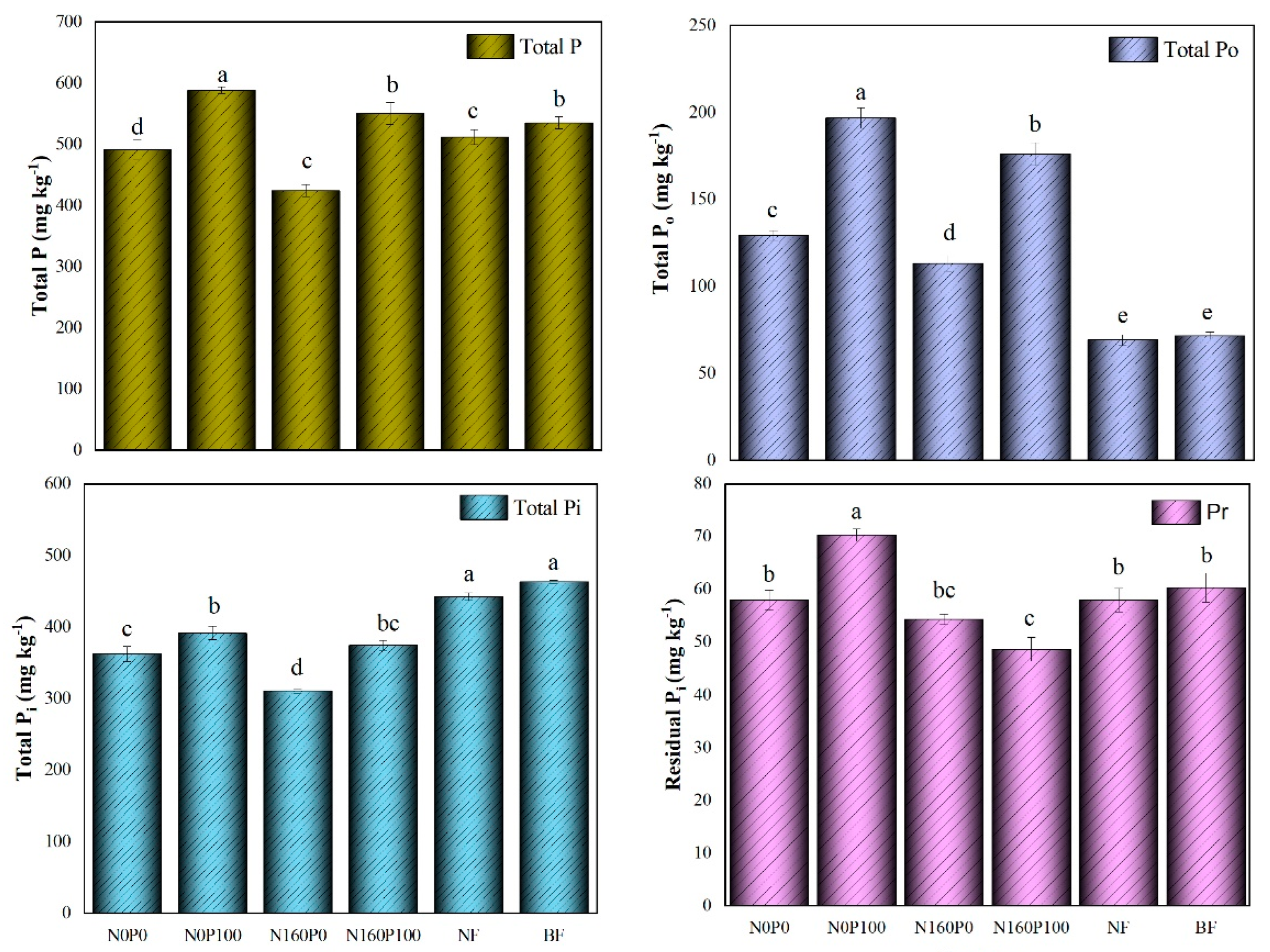

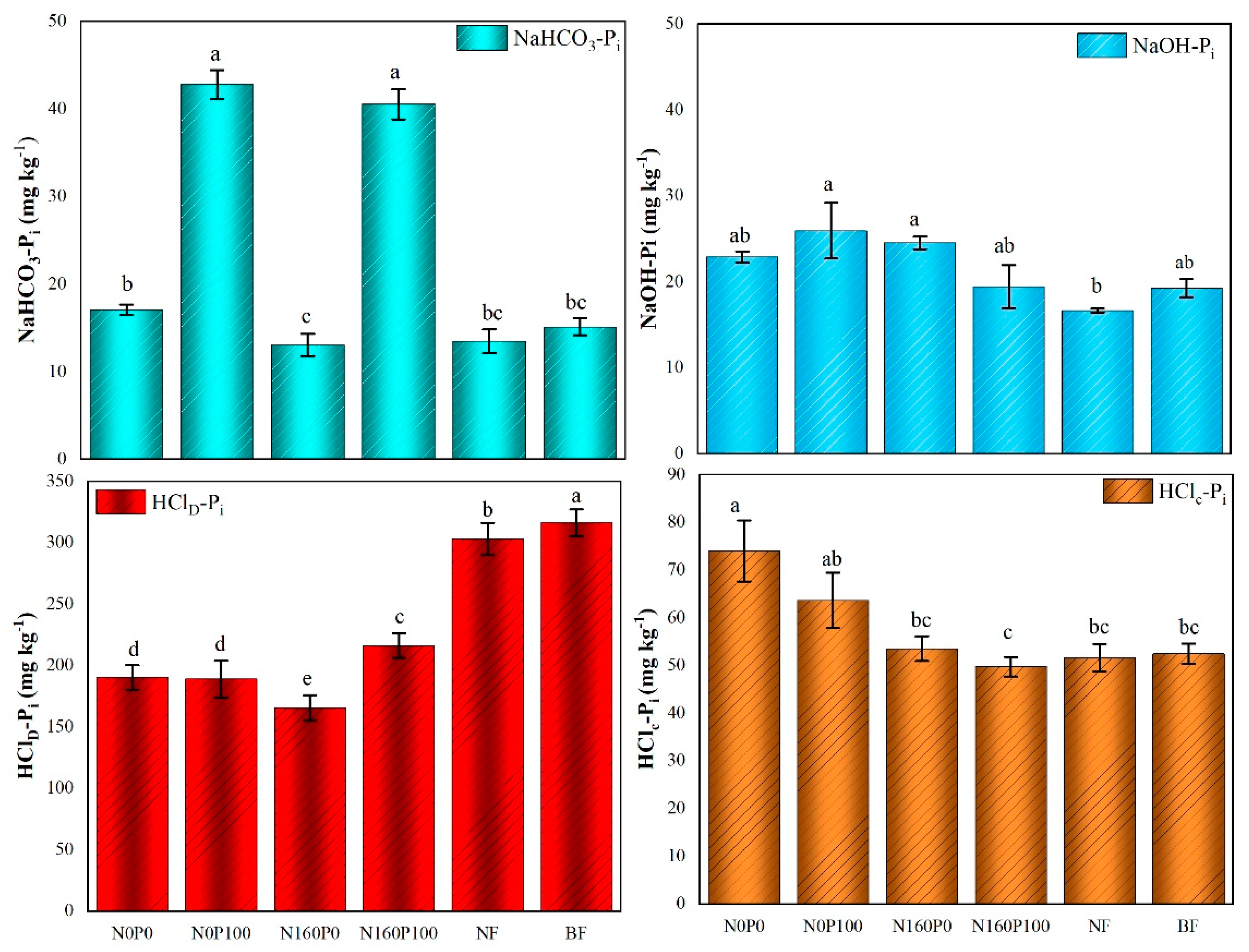
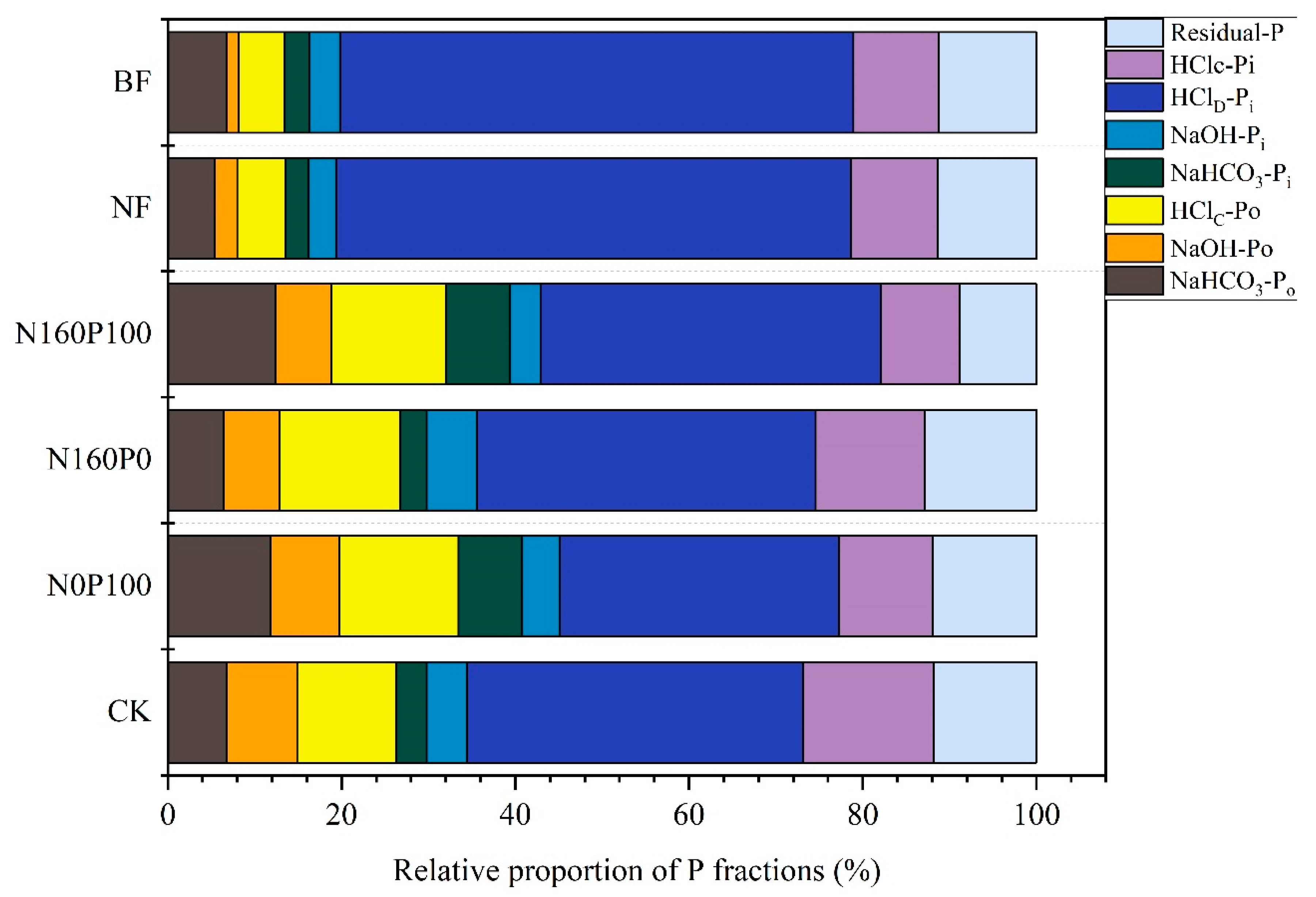

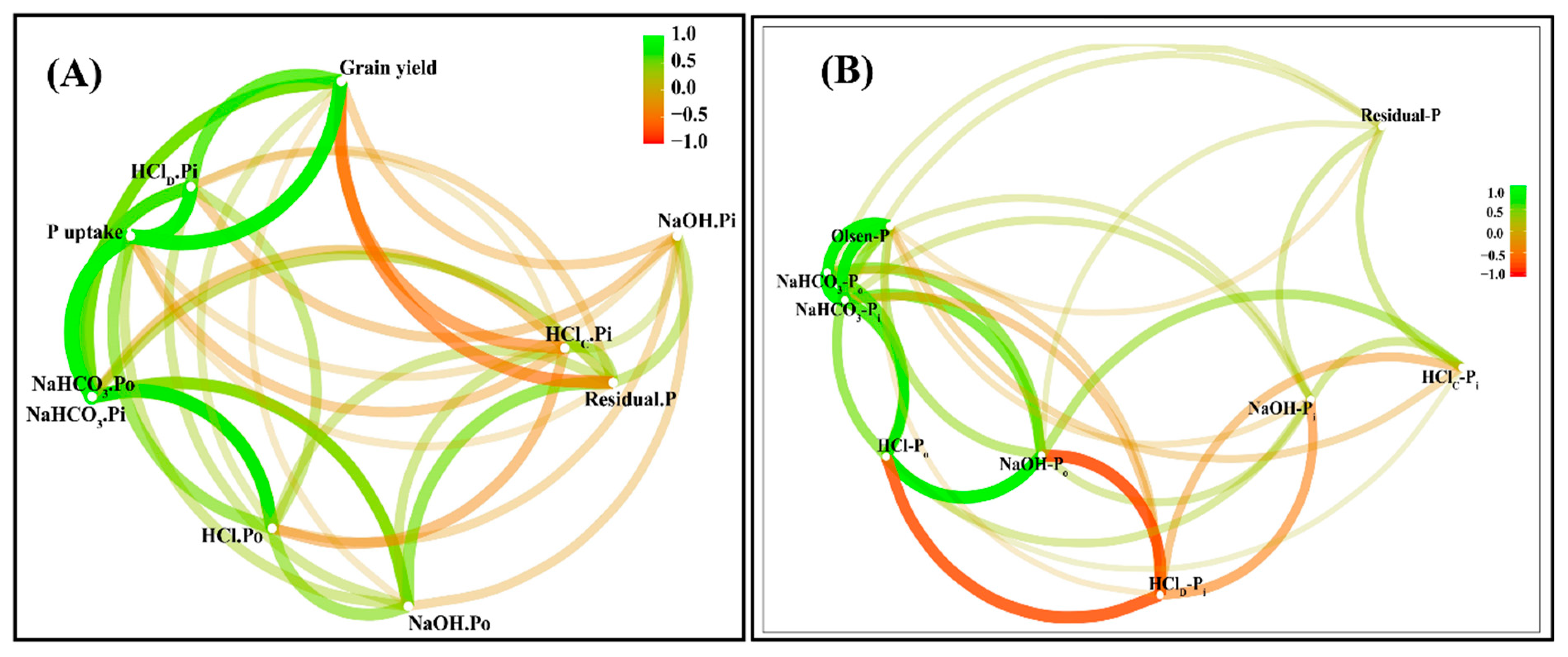
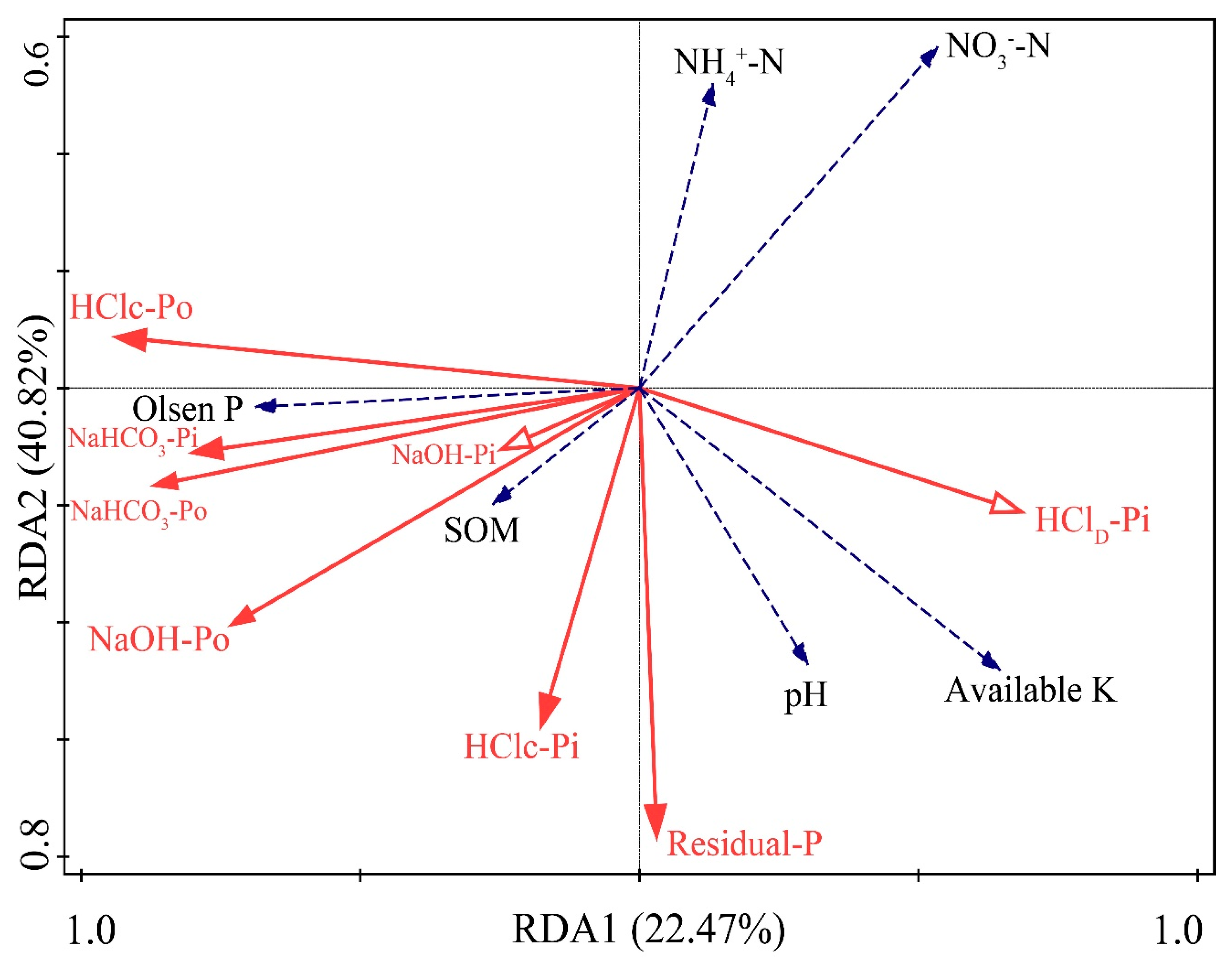
| Treatment | pH | NO3–-N | NH4+-N | Olsen P | Available K | Organic Matter |
|---|---|---|---|---|---|---|
| (H2O) | (mg kg−1) | (mg kg−1) | (mg kg−1) | (mg kg−1) | (g kg−1) | |
| N0P0 | 8.27 ab | 2.95 b | 0.32 a | 4.13 c | 155.04 b | 14.71 bc |
| N0P100 | 8.26 ab | 1.78 b | 0.11 a | 13.03 b | 154.65 b | 14.99 ab |
| N160P0 | 8.15 b | 6.88 a | 0.62 a | 3.70 c | 146.84 b | 13.47 cd |
| N160P100 | 8.19 ab | 7.20 a | 0.61 a | 20.33 a | 147.28 b | 15.21 ab |
| NF | 8.29 a | 7.06 a | 0.32 a | 6.41 c | 171.25 a | 16.21 a |
| BF | 8.31 a | 8.79 a | 0.46 a | 5.52 c | 167.67 a | 12.97 d |
| Treatment | NaHCO3-Pi | NaHCO3-Po | NaOH-Pi | NaOH-Po | HClD-Pi | HClc-Pi | HClc-Po | Residual-P | Total P | Grain Yield | P Uptake |
|---|---|---|---|---|---|---|---|---|---|---|---|
| N0P0 | 17.1 b | 33.2 bc | 22.9 ab | 39.9 b | 190.4 d | 74.0 a | 56.2 b | 58.0 b | 491.8 d | 2671 b | 9 c |
| N0P100 | 42.8 a | 69.7 a | 26.0 a | 46.5 a | 189.0 d | 63.6 ab | 80.8 a | 70.4 a | 588.8 a | 2938 b | 13 b |
| N160P0 | 13.1 c | 27.3 c | 24.5 a | 27.2 c | 165.5 e | 53.5 bc | 58.8 b | 54.4 bc | 424.3 e | 2964 b | 6 d |
| N160P100 | 40.5 a | 68.3 a | 19.4 ab | 35.6 b | 216.3 c | 49.8 c | 72.4 a | 48.7 c | 550.9 b | 5845 a | 17 a |
| NF | 13.5 bc | 27.5 c | 16.7 b | 13.3 d | 303.1 b | 51.6 bc | 28.6 c | 58.0 b | 512.3 c | .. | .. |
| BF | 15.1 bc | 36.0 b | 19.3 ab | 7.7 d | 316.2 a | 52.5 bc | 28.1 c | 60.4 b | 535.3 b | .. | .. |
Disclaimer/Publisher’s Note: The statements, opinions and data contained in all publications are solely those of the individual author(s) and contributor(s) and not of MDPI and/or the editor(s). MDPI and/or the editor(s) disclaim responsibility for any injury to people or property resulting from any ideas, methods, instructions or products referred to in the content. |
© 2023 by the authors. Licensee MDPI, Basel, Switzerland. This article is an open access article distributed under the terms and conditions of the Creative Commons Attribution (CC BY) license (https://creativecommons.org/licenses/by/4.0/).
Share and Cite
Mahmood, M.; Mehmood, S.; Ahmed, W.; Salah Elrys, A.; Tian, Y.; Hui, X.; Ayyoub, A.; Elnahal, A.S.M.; Li, W.; Wang, Z.; et al. Exploring Phosphorus Fraction Dynamics in Loess Soils: Impact of Long-Term Nitrogen and Phosphorus Fertilization on Cropland and Fallow Land. Sustainability 2023, 15, 12342. https://doi.org/10.3390/su151612342
Mahmood M, Mehmood S, Ahmed W, Salah Elrys A, Tian Y, Hui X, Ayyoub A, Elnahal ASM, Li W, Wang Z, et al. Exploring Phosphorus Fraction Dynamics in Loess Soils: Impact of Long-Term Nitrogen and Phosphorus Fertilization on Cropland and Fallow Land. Sustainability. 2023; 15(16):12342. https://doi.org/10.3390/su151612342
Chicago/Turabian StyleMahmood, Mohsin, Sajid Mehmood, Waqas Ahmed, Ahmed Salah Elrys, Yi Tian, Xiaoli Hui, Anam Ayyoub, Ahmed S. M. Elnahal, Weidong Li, Zhaohui Wang, and et al. 2023. "Exploring Phosphorus Fraction Dynamics in Loess Soils: Impact of Long-Term Nitrogen and Phosphorus Fertilization on Cropland and Fallow Land" Sustainability 15, no. 16: 12342. https://doi.org/10.3390/su151612342
APA StyleMahmood, M., Mehmood, S., Ahmed, W., Salah Elrys, A., Tian, Y., Hui, X., Ayyoub, A., Elnahal, A. S. M., Li, W., Wang, Z., & Liu, J. (2023). Exploring Phosphorus Fraction Dynamics in Loess Soils: Impact of Long-Term Nitrogen and Phosphorus Fertilization on Cropland and Fallow Land. Sustainability, 15(16), 12342. https://doi.org/10.3390/su151612342







